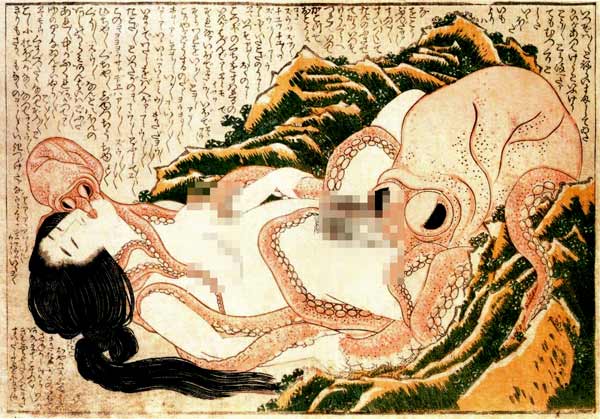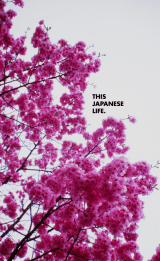There’s an old joke that any revolutionary tool mankind creates to express our highest ideals and ambitions will always simultaneously be used for pornography.
In Japan, that pornography-technology relationship is tied to scroll paintings and printmaking. Luckily for me, a major retrospective of erotic Japanese art, “Shunga,” or “Spring Pictures,” is on the display at the British Museum here in London.
The catalog consists of booklets, scrolls and wall hangings created from the 17th century up to the mid-19th, mostly for the benefit of instructing married couples on their sexual options, getting warriors turned up for battles, or “protecting property owners from fire,” an option I’m not sure I understand.
Girls on Wood
Let’s start with a brief history of the lewd: For one, Amaterasu, the Japanese Sun Goddess, once went into hiding in a cave, covering the land in darkness, and was lured out by a sexy dancer. This is one of the central myths of Japanese Shinto and says a lot about Japanese attitudes toward the sexy. At the exhibit in London, the attitude of this legend is juxtaposed with images of banned European erotica, which seem to portray angry statues of Zeus looking a bit murderous while penetrating terrified women.
Comparatively, the Japanese erotica is downright sensual, usually involving soft lines of fabric suggestively opening at the naughty bits of both parties. Some are oriented to women: One is a guide portraying feminine sexuality using the four seasons motif that is used for everything in Japan. The one violent scene on display depicts the rapist as a hairy, beasty slob with a pug nose.
Some have theorized that Shunga is gentler than ancient Western pornography because it was meant to be shared between partners, and that sexual equality was important to maintaining the wa for a stable household. But others – including Timon Screech, a lecturer and author of a book on Shunga — argue that the material was actually used as pornography for single men, and that the images of harmonious, frolicking couples sharing fulfillment are fantasies of an elusive mutual pleasure. Real sex would have been one-sided toward the pleasure of men: Though men would have longed for a wife who actually enjoyed sex, rather than tolerating it.
To that end, the books and scrolls on display portray sex in both a breezy and sensual fashion, whereas real sex may have been quite the opposite. Shunga were peddling fantasies, and that’s what’s on display.
Japanese Jokes of the 16th Century
One scroll includes a motif in bawdy traditional scroll-making that has gained infamy elsewhere: The Fart Battle. In the scroll displayed at the British Museum, Kyoto courtiers are portrayed as they have their enormous members measured by court officials. The portion of the scroll, dubbed “Size Contest,” is obviously ridiculous, with some men proudly displaying girth and width equal to their whole body. The description card wryly notes that one courtesan complained that “the thing” was “far too large” on all of them, and that “if it were depicted in the actual size, there would be nothing of interest.” Ouch.
Other scenes show women gaining the upper hand on conniving husbands. In one, a man is shown making love to a younger woman while his wife prepares to throw a snowball at him through the window. In another, the roles are reversed, a man finds his love “occupied” with another, so he climbs into a rosebush near their hay-making and farts on his rival, taking some of the magic out of the moment.
Some jokes truly are timeless.
I Know Why You’re Here
But perhaps the strangest of all Japanese woodblock pornography is the famous Hokusai image, “The Dream of the Fisherman’s Wife,” taken from the collection with a name that screams sex: “Pine Seedlings on the First Rat Day, or Old True Sophisticates of the Club of Delightful Skills” from 1814. In it, Hokusai – also famous for his masterpiece, The Wave – portrays a woman having sex with two octopuses, an image that has been widely copied across a variety of decades and media and is often exhibit number one for arguments that something is really weird about Japan. Here it is, updated to modern Japanese censorship standards:
(Hey, if the British Museum can do it, so can I).
The history of the image is actually pretty interesting, and one that might ring a bell to any modern-day pornography connoisseurs or, at least, people familiar with jokes about it. Back in the boom days of Shunga, publishers wanted to sell their pictures but were often hard-pressed to come up with stories. As a result, they often turned to making sexy parodies of classical literature.
One Noh play, “The Diver,” featured a scene where a heroine must dive underwater to rescue a jewel from the Dragon King, thus ensuring the safety of her homeland. Upon her return, she is blessed by priests, guaranteeing her salvation and rise to the pure land. You can imagine her gratitude from the book, thanking the priests profusely for their blessing – in Japanese, onkyo – telling them that she has longed for this onkyo, dreamed of it for years, etc.
Now imagine the porn parody taking that same scene and changing onkyo to inkyo. Then imagine that inkyo means “octopus penis.” Now we’re getting to the origins of Hokusai’s image. The parody-porn version in the original 1781 book bears a good resemblance to Hokusai’s later image, and Hokusai himself, as we know, sidelined in Shunga.
Other parodies are quite eccentric and prove the rule that somewhere, there is a porn version of everything: A pornographic version of a World Atlas and a pornographic version of a book that offered advice on noodle-making.
The Normal Stuff
Of course, Shunga wasn’t without controversy. The controversies, though, were often roundabout in their condemnations: One book was censored for showing “the mixing of classes,” another for revealing too much detail about the layout of a palace.
Otherwise, they were largely legal and unregulated until 1722, and zero books were published from 1722-1741, down from 1720’s peak of 12. Eventually, printers started testing the waters again, and found that they had significant legroom for getting away with it. By the time woodblock printing came around in 1765, there was a second explosion of mass produced Shunga materials, easily accessible and mass-produced. One cartoon from the time shows a bookseller worrying that people would quickly abandon “the normal stuff,” a complaint relevant to anyone who spends any time on 4chan.
Despite its ubiquity among every class in Japan – you could even buy a box of 109 Shunga greeting cards for your traditional gift exchange — the gray legality of being a pornographer remained. Most artists remained anonymous and publishers were careful not to be connected to them. Utagawa Kuniyoshi, for example, known as a master of Japanese woodblock printing, signed his shunga work only by painting a cat into each of his erotic scenes, calling himself – ahem – “The Wondrous Pussy.”
Kitagawa Utamaro, another classic artist of woodblock printing, was one example of why. His woodblock print portraying warlord Hashiba (Toyotomi) Hideyoshi and his five wives having an orgy at a cherry blossom party didn’t go over so well with the authorities back in 1804. Though Hideyoshi died in 1598, authorities quickly called Utamaro out for using Hideyoshi’s real name (I kid you not, the preferred practice at the time was to refer to “Mashiba Hisayoshi” when portraying dramatized accounts of Hideyoshi’s life).
Utamaro was imprisoned for a month or less, but was humiliated and crushed. He never produced pornography, or any of his traditional woodblocks, again, and died two years later.
Censorship crested again when Commodore Matthew Perry arrived with guns a’blazin, demanding Japan open its ports so the Western world could force body shame on everybody on the planet. They soon succeeded, and censorship laws roared anew, essentially ending all production of Shunga aside from the far, far underground markets.
All this unreleased sexual tension eventually lead to the start and end of the Second World War. That’s when, alongside many other things, censorship laws were placed into Japanese law, forbidding the display of erotic imagery. This law, which is still on the books, was actually applied to Shunga wood block prints all the way up to 1989. Before that, even modern scholars were asked to blotch out any naughty bits from the work they were printing in academic journals or books.
If you’re in London before January 5, 2014, stop by the British Museum to see a lot more of this stuff with quite a nice collection of examples and other… erotic artifacts from the era.
If you’ve been rejected from the “Club of Delightful Skills,” you might like This Japanese Life on Facebook. Also, I wrote a book you should read!








I’m not going to lie, when I saw Matthew Perry I got really concerned, but props for the historical joke. Great article.
The article should not say “onkyo” but onkei 恩恵.
Then penis is inkei 陰茎
Then the story makes sense.
I’m assuming it’s an archaic Japanese. If not, it’s in the British History Museum to fix it. I’ll defer to them.